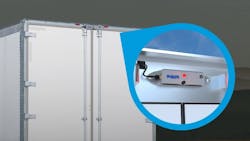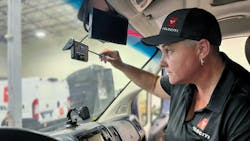Fleets embrace AI dashcams as best defense against 'sue-happy' society
“Everyone in this climate is sue happy,” Tim Guy, VP of safety at RoadSafe Traffic Systems, told Fleet Maintenance at Motive Vision 25, talking about the current nuclear verdict climate surrounding trucking. “If there’s a logo on it, you can get attacked, even if you’re doing everything right.”
He also added that some nuclear verdicts “have just been through the roof,” which has shaken both fleets and their insurers.
“Everyone’s kind of in a panic on what they’re going to do,” Guy surmised.
For the last seven months, what RoadSafe has done is implement Motive’s AI dashcams. And it’s working. On the exoneration side, Guy said, “There are many examples where the camera technology has saved us, because we are able to prove how our drivers were doing everything right.”
The coaching strategy depends on the situation, though. Guy said at times the AI in-cab voice alerts, like those for speeding, are enough, while “sometimes you need to pull the driver off the road and have that one-on-one conversation.”
Veit has used Motive’s dual-facing cameras for more than two years. The specialty contractor fleet has them on 75% of its fleet, with the rest planned to get the technology this summer, according to Jon Somerville, Veit’s fleet safety manager. He noted the AI coaching serves as “a proactive system with in-cab alerts.”
When drivers are engaged in risky behaviors, the system lets them know. “And if they don’t change that behavior, that’s when an event is created,” Somerville said, adding “we use it primarily for coaching and not for discipline.”
Motive recently revealed its AI Coach feature, which generates an AI safety instructor (that looks like a real person) to provide drivers with positive reinforcement and point out what behaviors have been impacting their safety score. Guy’s likeness was used for a demo at Motive’s conference.
Somerville isn’t quite sure he’s ready for this advancement.
“I like to FaceTime with the driver; I want them to know that I care about what they’re doing, and I don’t know if that can be conveyed very well through AI,” he said. “I think it’s a neat feature and a useful tool, but probably not the direct route I’m going to go.”
The inward cams are viewed by some as an invasion of privacy, which is why Guy reminded that acceptance and compliance cannot happen without first discussing intent with drivers.
Driver buy-in is one of the most important factors, noted Alain Samaha, president and CEO of Teletrac.
“It’s not just about the fleet operator or the safety manager at the fleet deciding that this is good,” he said. “It’s about the adoption from the driver’s perspective, from a privacy perspective—that’s the key element.”
Guy agreed.
“Once you have that logical conversation with the drivers, their buy-in just changes immediately, because they know we’re not spying on them; we’re just really giving them a tool to correct their behaviors.”
He estimated a fleet’s safety department will have to provide more personal coaching to about 20% of their drivers to get them to embrace in-cab AI coaching.
Samaha said fleets may first want to start with forward facing because “there’s a privacy element to the driver that comes into play.” He noted unions and other factors could also play a role in using driver-facing cameras.
Once you start, you may want to cover the whole tractor-trailer. Phillips Industries now offers a REAR-VU Backup Camera that mounts above the trailer doors, and is viewed through a connected iPhone/iPad, Android smart device, or ELD. The driver can view 170 degrees of the rear—to as far as 100 feet behind the trailer. This makes it a handy blind-spot monitor. Hofly said install time is about 10 to 15 minutes and it plugs directly into the trailer harness. And data can go right to the cloud through Phillips Connect’s trailer telematics.
Wabash made it standard on new dry van trailers, ensuring that if someone erratically drives directly into a trailer, the jury can see that—and not just the crumpled wreckage post-accident.
Benefits of AI dashcam adoption
Overall, AI dashcams are still in the early stage of adoption, Samaha said. A recent survey by Teletrac Navman suggested that a quarter of fleets are using or piloting AI safety solutions as a whole, with another 18% in the exploration phase.
Jeff Martin, global director of safety at Lytx, said American Trucking Associations members have typically been early adopters, while now “we’re seeing interest all the way down to the field services sectors.”
That’s because even a mobile maintenance truck is a “rolling billboard” and those companies “realize that they’re an incident away from a claim that could wipe them out.”
More and more fleet customers, recognizing their brand could also be impacted by a fatal accident, now require certain safety thresholds, which dashcams can help achieve, Martin said, adding it’s an expectation from insurers today as well.
“The minimum is an outward-facing dashcam,” he said. “You’ve got an instant reconstruction [of an accident]. This is playing up a defense, and that’s when you end up settling.”
Fleets adopting dashcams may also find that their safety culture rapidly improves. For instance, if a fleet sets a speed threshold of 5 mph over, and several drivers’ dashcams detect them exceeding that, the company can center safety training around why that is unacceptable via group coaching and daily reminders.
A fleet using dual-facing cams can also select a specific unsafe behavior to correct. Martin said in addition to speeding, the top behaviors that can get people killed (and increase the likelihood of a nuclear verdict) are inattentiveness/distraction, following too close, and seatbelt compliance.
“Those sorts of things allow companies to be proactive, following the reactive understanding of what is developing or trending,” Martin said.
RoadSafe’s Guy described the video data as a sort of safety diagnostics tool, something to help fleets “get down to [the] root cause of accidents and injuries.” And the instant coaching feature ultimately sets an overall tone for the safety culture needed to truly decrease a fleet’s crashes and the probability of a nuclear verdict.
One final note about adopting dashcams, which is true of any new technology, is they always need to be installed and may get damaged and need repairs or replacements. And for larger fleets, keeping track of hundreds or thousands of these devices can be a challenge.
Because Velociti’s internal data found 20% of a fleet’s onboard technology, such as dashcams, fail over 12 months (usually due to loss of power or physical damage by a driver), the maintenance management company rolled out a program called VeloCare Unlimited to help fleets monitor and manage safety technology health and inventory, as well as send techs out to make repairs. And the cost— $0.00048 cents per mile—is the inverse of nuclear verdicts.
“We understand trucking companies operate on razor-thin margins,” Velociti CEO Deryk Powell noted at TMC 2025, which is why the management solution is “intentionally structured at an almost negligible cost.” Powell said an audit of one fleet’s 3,000 dashcams discovered 16.7% were out of commission, and when those trucks with non-functioning dashcams got in an accident, the fleet paid $2 million more in total versus one with working dashcams.
Now that is truly a scary thought, so as with any onboard technology, have a maintenance plan in place.
About the Author

John Hitch
Editor-in-chief, Fleet Maintenance
John Hitch is the award-winning editor-in-chief of Fleet Maintenance, where his mission is to provide maintenance leaders and technicians with the the latest information on tools, strategies, and best practices to keep their fleets' commercial vehicles moving.
He is based out of Cleveland, Ohio, and has worked in the B2B journalism space for more than a decade. Hitch was previously senior editor for FleetOwner and before that was technology editor for IndustryWeek and and managing editor of New Equipment Digest.
Hitch graduated from Kent State University and was editor of the student magazine The Burr in 2009.
The former sonar technician served honorably aboard the fast-attack submarine USS Oklahoma City (SSN-723), where he participated in counter-drug ops, an under-ice expedition, and other missions he's not allowed to talk about for several more decades.


